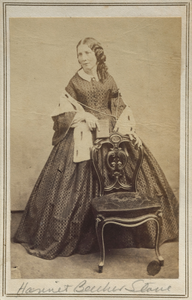Description
Born Litchfield, ConnecticutDriven by the desire to “make [the] whole nation feel what an accused thing slavery is,” Harriet Beecher Stowe began work on a dramatic novel in response to the passage of the draconian Fugitive Slave Law of 1850. The result was Uncle Tom’s Cabin; or, Life Among the Lowly, the groundbreaking bestseller that so altered the public’s perception of slavery that it has been described as “one of the most successful feats of persuasion in American history.” First serialized in the National Era newspaper, Uncle Tom’s Cabin appeared in book form in 1852 and sold more than three hundred thousand copies during its first year in print.The impact of Stowe’s novel extended far beyond the United States. An international success, it contributed to the abolition of serfdom in Russia following its publication there in 1857. Widely read in Britain, Uncle Tom’s Cabin was also credited with fueling that nation’s refusal to recognize the Confederacy during the Civil War.Alexander Purdy, National Theater, New York. George P. Howard, Marion, Mass.; purchased by NPG December 1967.
Image
Oil On Canvas
National Portrait Gallery, Smithsonian Institution
Record Contributed By
National Portrait GalleryRecord Harvested From
Smithsonian InstitutionKeywords
- Abolitionist
- Abolitionists
- Chair
- Chairs
- Costume
- Design
- Female
- Fisher, Alanson
- Furnishings
- Furniture
- Harriet Elizabeth Beecher Stowe
- Home Furnishings
- Interior
- Interior Decoration
- Jewelry
- Literature
- Novelist
- Novelists
- Pin
- Portrait
- Portraits
- Reformer
- Reformers
- Seating
- Society And Social Change
- Stowe, Harriet Elizabeth Beecher
- Women
- Writer
- Writers





















